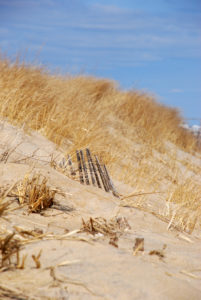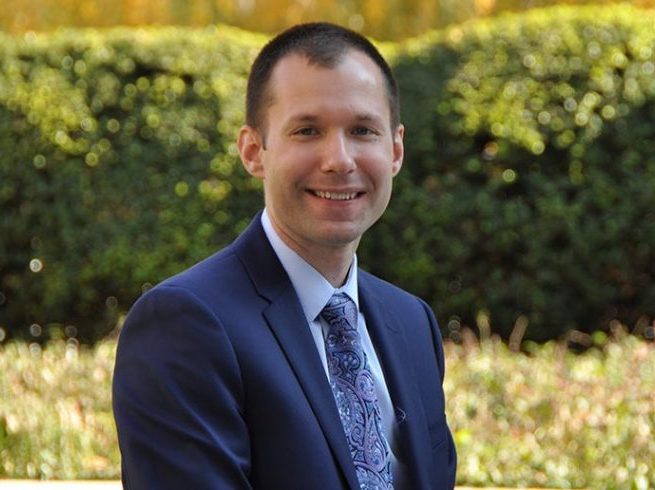By Hannah Gonzalez

Growing up on the barrier islands of the Jersey Shore, Colleen Cochran, FCRH ’21, had always loved the beach. But when she was in eighth grade, her coastal community was greatly impacted by Hurricane Sandy. In the face of this devastation, Cochran dedicated herself to improving the coast and public perception of beach maintenance.
Cochran, an environmental studies major, worked for three years on a project titled “What We Know and What We Think We Know: Common Coastal Management Facts and Misconceptions.” The study looks at public understanding of the coast, and its findings show a need for greater educational initiatives to promote local protection of the shore. Cochran said her work can help inform future practices.
“The study will help pave the way for future management practices, and illuminate the misconceptions that are preventing proper coastal management,” said Cochran.
Cochran’s research into coastal management began after the hurricane, when the dunes in her neighborhood had become completely engulfed by the ocean. Her community was tasked with rebuilding these protective structures.
“In the wake of that, I became really inspired to help my community,” she said.
As a freshman in high school, she began developing a research project on building dunes, using fencing to trap the sand.
“That’s how dunes grow and become great ecosystems and protective barriers,” said Cochran. “From there, I started this research journey where I was really interested in dune ecology.”
As a sophomore in high school, she met her mentor, Bianca Charbonneau, a student at the University of Pennsylvania. They discussed the politicizing of coastal management in the aftermath of Sandy, and together decided to look at the community’s relationship with the coast from the perspective of locals.
“We thought it would be really great to take a social science study where we asked beachgoers, long term residents and oceanfront homeowners what they thought,” said Cochran.
They partnered with Christine Avenarius, an anthropology professor at East Carolina University, for help in conducting surveys.
For the following two summers, Cochran walked beaches, malls and festivals for the input of locals in Ocean and Monmouth Counties. In the first phase, she explored the perspectives of beachgoers on the Jersey Shore, amassing the opinions of 48 participants from 20 open-ended questions. The second summer, Cochran went to festivals, fairs and malls for a diverse array of community participants. In this phase, 300 participants responded to 16 agree/disagree questions.
Cochran said approaching beachgoers could be difficult, as many did not want to stop to take a survey. However, she emphasized the significance of hearing open-ended feedback, as opposed to the limitations of online surveying.
“I was going along the beach and having interviews with people, and actually being able to get their open-ended responses, which is what I was able to analyze last semester,” said Cochran. “I was able to really see how they convey their opinions, what language they use, because that’s so important to understand.”
Cochran entered Fordham as a freshman that fall. At the encouragement of Professor John van Buren of the environmental studies department, she applied for and received a grant through Fordham to continue her research.
Last semester, Cochran developed a word features algorithm in Python to look at the opinions and word choice of survey participants in response to different coastal issues, as well as potential areas of miscommunication. With this information, she was able to identify gaps in education with regards to coastal management.
“One of our biggest findings was that, although we have so many residents who are in support of coastal management and the construction and maintenance of dunes, they don’t know a lot about the processes that go into that,” said Cochran.
There was a general lack of participant knowledge in the role of fencing and vegetation on dune maintenance. Many favored beach replenishment, a costly method of restoring beaches which actually causes dunes to erode more quickly. To Cochran and her team, this pointed to the educational gaps currently present in public understanding of dunes.
“We’re trying to, with all this data, develop educational messages to persuade them more toward a living shoreline,” said Cochran. “Especially since a lot of participants preferred natural beaches, which showed that there’s room for persuasion and education.”
Cochran’s Python program helped her develop messages which would help educate the public about sustainable methods of coastal maintenance. She hopes for change in education at a township level, where residents can make informed decisions about how to manage their own beaches.
“It’d be very influential for actual coastal managers to have this information and be able to pass it on to residents, as they are so interested but don’t really have the knowledge,” said Cochran.
Since the completion of the project, Cochran has presented at Fordham’s Undergraduate Research Colloquium in December. She gave talks at the Undergraduate Research Symposium and the Research Preview Night last week. In two weeks, she will present at the Fordham/Columbia/NYU Sustainable Cities Conference.
Next, Cochran and her colleagues will submit their work to the Journal of Coastal Management for publication.
“Hopefully it will be very helpful to a lot of policymakers, and really helpful for coastal management as a whole,” said Cochran.
Going forward, Cochran will be working with Steven Franks, Ph.D., of the biology department to research the photosynthesis of American beachgrass, a key management species for dune structures. She has received a grant for this project, which she will be working on over the summer.
“It’s really important to understand the eco-geo-physiological features going on in the dunes for resource flux and invasibility when considering maintenance practices as well,” said Cochran.












































































































































































































